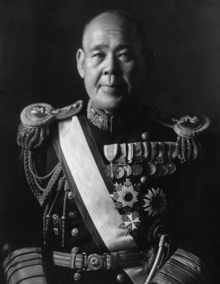This article includes a list of general references, but it lacks sufficient corresponding inline citations. (April 2024) |
You can help expand this article with text translated from the corresponding article in Japanese. (November 2024) Click [show] for important translation instructions.
|
Osami Nagano | |
|---|---|
永野 修身 | |
 Osami Nagano (c.1943-45) | |
| Minister of the Navy Empire of Japan | |
| In office 9 March 1936 – 2 February 1937 | |
| Monarch | Shōwa |
| Prime Minister | Kōki Hirota |
| Preceded by | Ōsumi Mineo |
| Succeeded by | Yonai Mitsumasa |
| Chief of the Imperial Japanese Navy General Staff | |
| In office 9 April 1941 – 21 February 1944 | |
| Prime Minister | |
| Preceded by | Prince Fushimi Hiroyasu |
| Succeeded by | Shimada Shigetarō |
| Personal details | |
| Born | June 15, 1880 Kōchi, Kōchi Prefecture, Japan |
| Died | January 5, 1947 (aged 66)[1] Sugamo Prison, Tokyo, Occupied Japan |
| Awards |
|
| Military service | |
| Allegiance | |
| Branch/service | |
| Years of service | 1900–1947 |
| Rank | |
| Commands |
|
| Battles/wars | Russo-Japanese War World War I World War II |
Osami Nagano (永野 修身, Nagano Osami, June 15, 1880 – January 5, 1947) was a Marshal Admiral of the Imperial Japanese Navy and one of the leaders of Japan's military during most of the Second World War. In April 1941, he became Chief of the Imperial Japanese Navy General Staff. In this capacity, he served as the navy's commander-in-chief in the Asia-Pacific theater of World War II until his removal in February 1944. After the war, he was arrested by the International Military Tribunal for the Far East but died of natural causes in prison during the trial.
- ^ Nishida, Imperial Japanese Navy
- ^ a b Nagano Osami at navalhistory.flixco.info